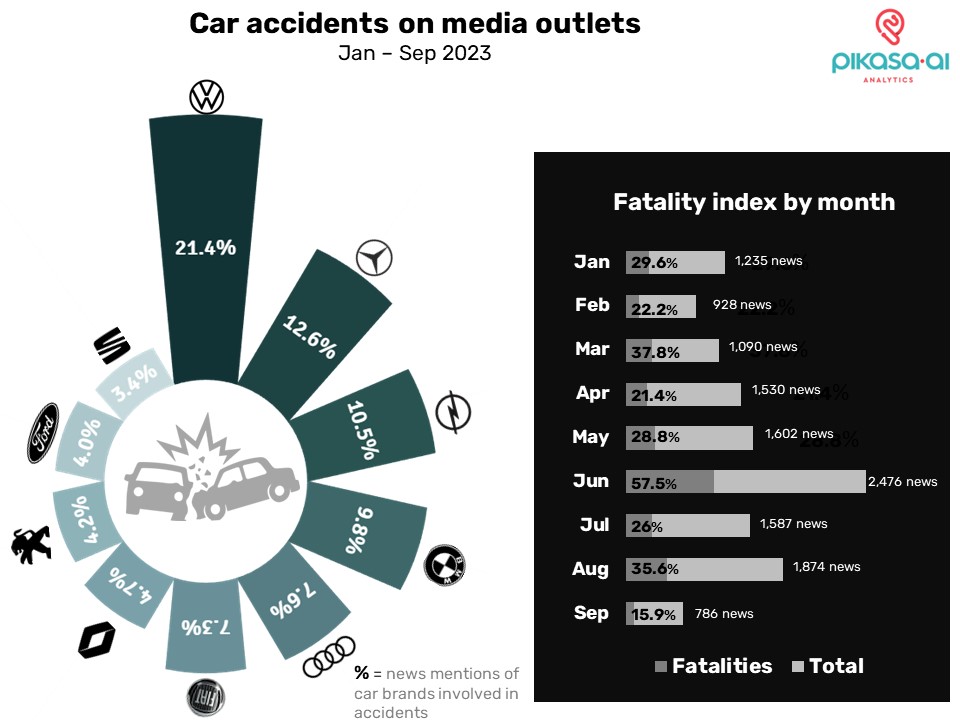
For the nine months of this year, North Macedonia witnessed an alarming surge in media coverage, with over 13K news articles dedicated to the pressing issue of car accidents. These accidents, often with devastating consequences, have raised concerns about road safety and the human toll exacted by these incidents. Our analysis delves into this extensive body of news reporting, aiming to shed light on the car brands frequently associated with these accidents and the grim outcomes involving injured or deceased individuals.
One of the key aspects of our analysis revolves around the car brands most frequently mentioned in connection with these accidents.
Another vital dimension of our analysis is the human cost of these accidents. We have sought to determine from the news who were either injured or tragically lost their lives in these incidents.
The analysis conducted by Pikasa on all car brands active in the North Macedonian market has revealed significant insights into the prevalence of car brands involved in accidents. The results demonstrate a clear hierarchy of car brands in terms of their involvement in accidents:
The data indicates that Volkswagen cars account for a substantial 21.4% of the vehicles involved in accidents, Mercedes-Benz cars make up 12.6% of the vehicles involved in accidents, Opel cars represent 10.5% of the vehicles in accidents, BMW cars comprise 9.8% of the accident-involved vehicles. This indicates that BMW vehicles are also more frequently seen in accident reports, Audi vehicles account for 7.6% of accidents, adding to the list of well-known brands linked to road accidents, followed by car brands as Fiat, Renault, Peugeot, Ford, Seat, etc.
The remaining percentage encompasses various other car brands not specified in the analysis, highlighting that there are many other car manufacturers with a smaller but still significant presence in accident reports.
The other critical aspect of our analysis focuses on assessing the severity of car accidents in North Macedonia, particularly those that result in wounded or deceased individuals. Understanding the human toll of these accidents is essential for comprehending the full scope of the issue and guiding efforts to improve road safety.
Our analysis has revealed the following distressing findings:
Injured Individuals: Within the 13,108 news articles on car accidents, a significant number report incidents resulting in injuries. These injuries can range from minor to severe, with varying degrees of impact on the lives of those involved. The data show that a substantial portion of these accidents led to individuals sustaining injuries, some of which may have long-term consequences. The accidents solely involving injuries constituted 66.4% of the total number of news articles.
Fatalities: Equally troubling is the presence of accidents that tragically result in loss of life. Our analysis indicates that a portion of these accidents had fatal outcomes, leaving families and communities to grapple with the profound and irreversible effects of these tragedies. Accidents resulting in fatalities, where in addition to injuries there were also victims, accounted for 33.6%. The month of June recorded the highest fatality rate in car accidents by 57.5% from the total news.
Methodology
Pikasa used its analytics.live media intelligence platform to conduct real-time online monitoring of more than 3000 media in the Western Balkans Region, Bulgaria, Moldova, Ukraine, Kazakhstan, Belarus and Baltic countries.
The analytics platform monitors media articles along with their respective penetration on social network platforms (Facebook, Instagram, YouTube, TikTok, LinkedIn, Telegram, VK and Odnoklassniki) counting all types of activities and engagements.